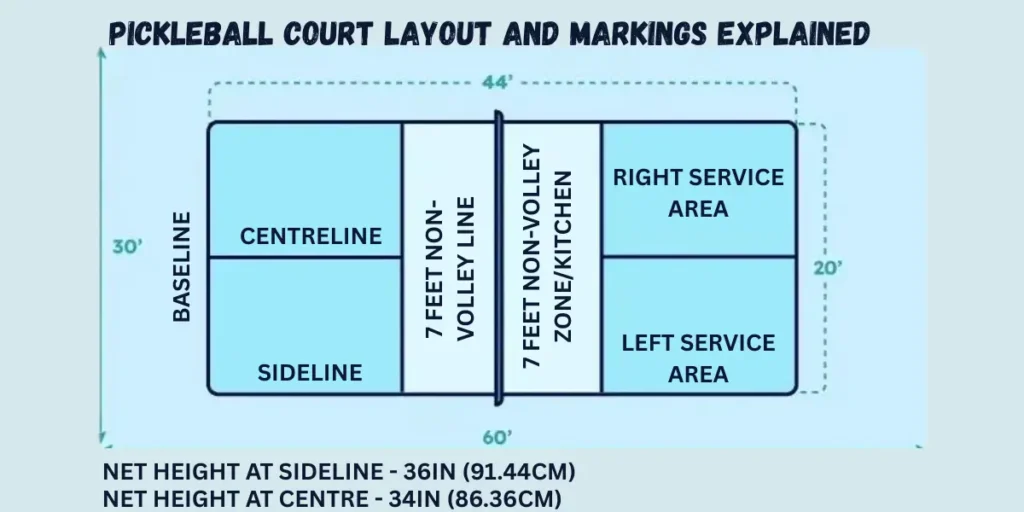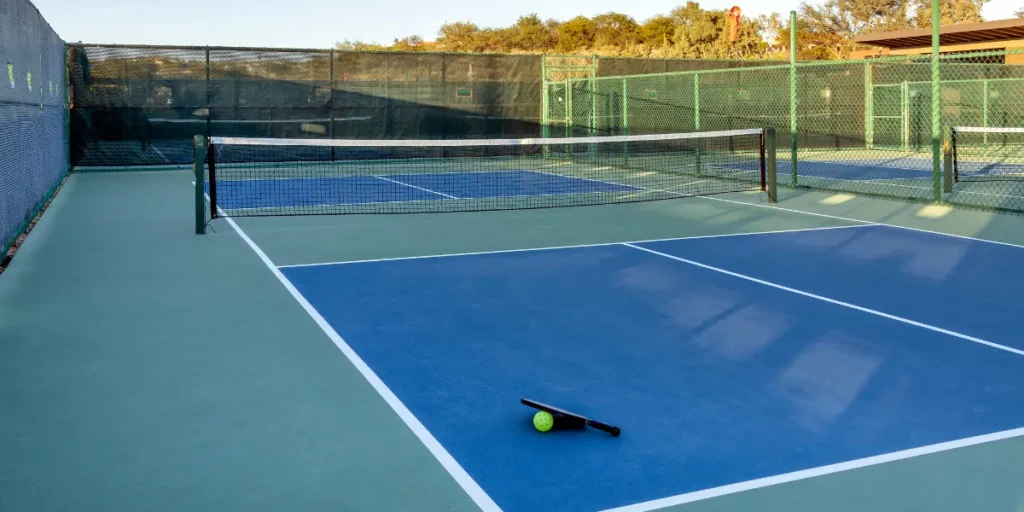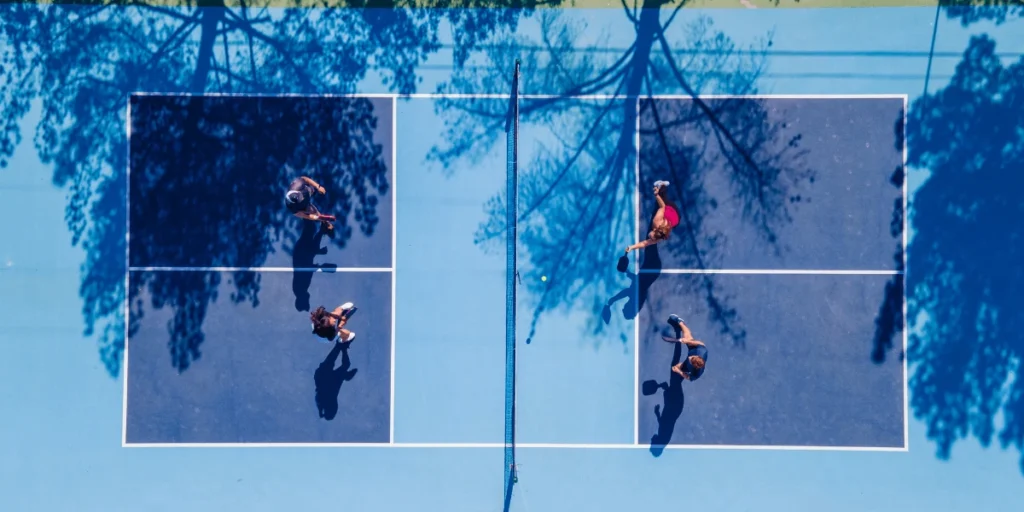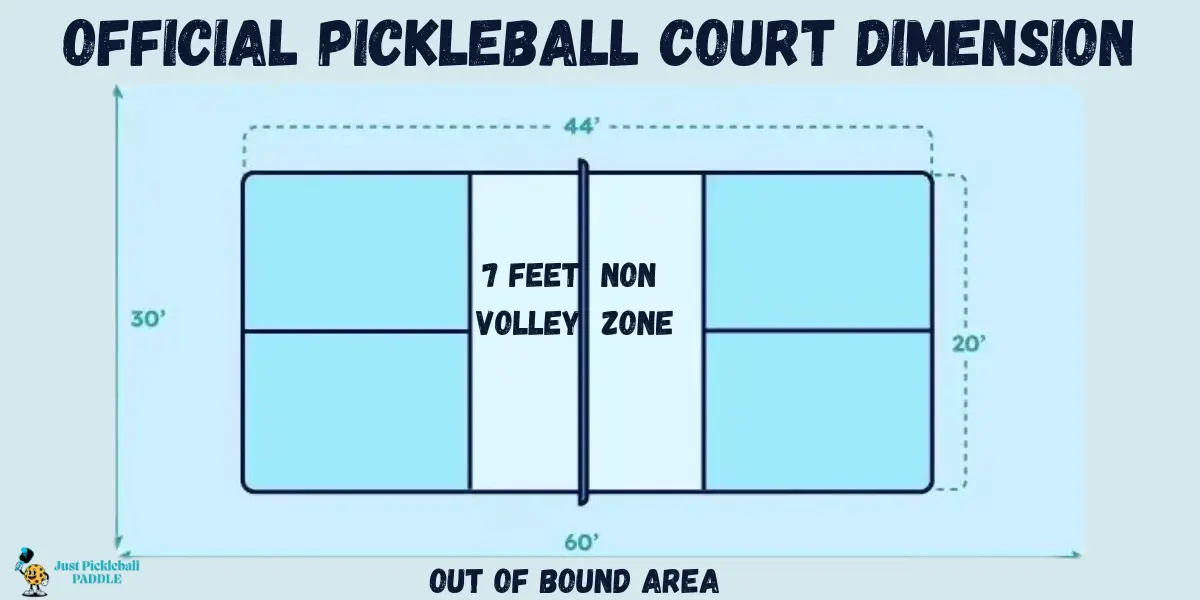Pickleball has taken the world by storm, combining elements of tennis, badminton, and ping pong. Whether you’re planning to build a court or simply curious, understanding how big a pickleball court is can help you get started the right way.
A standard pickleball court measures 20 feet wide by 44 feet long, the same dimensions used for both singles and doubles play. This size is consistent across all official tournaments, including pickleball championships, and aligns with the specifications set by governing bodies like USA Pickleball.
But that’s just scratching the surface. Let’s break down every detail, from pickleball court dimensions diagrams to variations for smaller spaces and indoor use.
Standard Pickleball Court Dimensions (Feet & Meters)
The official size of a pickleball court is 20 feet wide and 44 feet long (approximately 6.10 meters by 13.41 meters). These measurements are standardized for all levels of play, whether it’s a casual match or a professional championship.
One of the unique features of pickleball is that the same court dimensions are used for both singles and doubles play, which simplifies the setup and allows for more consistent game flow.
Here’s a breakdown of the court’s key measurements in Feet and Meters:
| Court Element | Measurement (Feet) | Measurement (Meters) |
|---|---|---|
| Total court size | 20 ft x 44 ft | 6.10 m x 13.41 m |
| Non-volley zone (kitchen) | 7 ft from the net | 2.13 m |
| Service area (each side) | 10 ft wide x 15 ft long | 3.05 m x 4.57 m |
| Baseline to net (half court) | 22 ft | 6.70 m |
| Sideline to sideline (width) | 20 ft | 6.10 m |
| Baseline (width of court) | 20 ft | 6.10 m |
| Sideline (length of court) | 44 ft | 13.41 m |
| Net height (center) | 34 inches | 0.86 m |
| Net height (sidelines) | 36 inches | 0.91 m |
| Total surface area | 880 ft² | 81.75 m² |
The non-volley zone, also known as the kitchen, extends 7 feet from the net on both sides and spans the full width of the court. Each side of the court is divided into left and right service boxes, each measuring 10 feet wide by 15 feet long.
These standard measurements are essential for building, marking, or playing on a regulation pickleball court and ensure consistent gameplay across all environments.
Small and Minimum Pickleball Court Dimensions
While 20 feet by 44 feet is the official playing surface for pickleball, the minimum recommended space for safe gameplay, including room to move and avoid obstacles, is 30 feet wide by 60 feet long. This additional space ensures players can serve, rally, and move freely without the risk of running into surrounding structures.
For more compact or casual setups, smaller dimensions such as 26 feet by 50 feet are sometimes used. These are fine for recreational games, but do not meet the standards for official matches or tournaments.
Minimum space recommendations:
- Casual play: At least 26 ft x 50 ft
- Comfortable play: 30 ft x 60 ft (ideal for backyard use)
- Tournament standard play area: 34 ft x 64 ft
Note: Even if you’re not using regulation dimensions, maintaining the correct court proportions and markings still allows for enjoyable, skill-building practice.
Pickleball Court Layout and Markings Explained
Once the court dimensions are measured and the layout is planned, the next step is to mark the surface accurately. A properly marked court ensures fair play and smooth gameplay, especially when multiple players or teams are involved.

- Baselines: These form the back boundary lines on each end of the court.
- Sidelines: These run the length of the court and mark the side boundaries.
- Non-volley zone (kitchen): Extends 7 feet from the net on both sides. Players cannot volley (hit the ball out of the air) while standing in this zone.
- Centerlines: These split each side into left and right service areas.
Each of these lines is typically 2 inches wide and should be painted in a color that clearly contrasts with the court surface. Consistency in marking ensures that players can easily judge serves, rallies, and fault calls.
Whether you’re using paint, chalk, or court tape, precise markings are essential for both recreational and professional use. Proper layout not only ensures compliance with official rules but also enhances the overall quality and safety of the game.
Pickleball Net Height and Specifications
In pickleball, the net is slightly lower in the center than at the sides. The official height is 36 inches at the sidelines and 34 inches at the center. This subtle dip helps promote balanced gameplay and smoother rallies.
- Net height at the sidelines: 36 inches (91.44 cm)
- Net height at the center: 34 inches (86.36 cm)
- Net width: Spans the full 20-foot width of the court
- Material: Most nets are made from durable mesh such as polyethylene or vinyl-coated polyester
- Center strap: Used to maintain the correct dip at the center
The net is supported by two posts placed just outside the sidelines. These posts must not interfere with play and should be stable enough to keep the net tight throughout the game.
For backyard or temporary courts, portable net systems are available that meet the regulations of pickleball net height and width standards. Just be sure to measure before playing, especially on uneven surfaces.
Ensuring the net is set up correctly is a small but essential step in creating a court that feels professional and plays smoothly, whether it’s for casual matches or competitive play.
Indoor vs Outdoor Pickleball Court Dimensions
While the dimensions of a pickleball court remain the same indoors and outdoors, 20 feet wide by 44 feet long, there are a few key differences worth noting when it comes to layout, surface, and overall playability.
One of the most noticeable differences lies in the court surface. Indoor courts are typically built on wood or synthetic gym flooring, which provides more bounce and softer footing. In contrast, outdoor courts are usually made of concrete or asphalt with a textured acrylic coating for durability and grip under varying weather conditions.

Lighting also plays a major role. Indoor courts rely on consistent artificial lighting, which must be even and shadow-free. Outdoor courts depend on natural daylight or floodlights, which can affect visibility depending on the time of day and weather.
There’s also a difference in how the court is used or marked. Many indoor facilities are multi-use, so pickleball lines might be overlaid on existing basketball or volleyball courts. Outdoors, the court is often dedicated to pickleball, making line visibility and spacing more consistent.
Another factor to consider is the types of Pickleball balls. Outdoor pickleball balls are heavier and designed to resist wind, while indoor balls are lighter with larger holes, suited for smooth indoor surfaces.
Despite sharing identical measurements, indoor and outdoor pickleball courts offer different playing experiences. Understanding these differences can help you better prepare, whether you’re setting up a court or transitioning between environments.
Building or Installing a Pickleball Court
After understanding the court dimensions, layout, and the differences between indoor and outdoor play, the next step for many players and facility owners is to build a court, either for personal use or as part of a larger community setup. The approach you choose depends on your goals, available space, and budget.
For casual setups, many people begin with backyard or driveway courts using court tape and a portable net system. This offers a flexible and affordable way to enjoy the game at home. While it doesn’t meet official tournament standards, it works well for practice and recreational play.

Those planning to build a permanent outdoor court need to account for several important factors: proper site grading, accurate measurements, surface material, and weather protection. Most professional courts are built using asphalt or concrete, topped with an acrylic coating for added grip and durability.
For more details on this, see our guide on what pickleball courts are made of.
Estimated costs of a Pickleball court:
- Backyard setup (temporary): $300–$800
- Permanent single court: $5,000–$15,000+, depending on surface and features
- Multi-court installations: $30,000 or more, especially with fencing, lighting, or seating
Optional additions like fencing, lighting for night games, wind screens, or spectator seating can raise the cost, but are often essential for clubs or community centers planning to host events.
Another common option is converting existing tennis or basketball courts. With minimal investment in line painting and a portable net, these surfaces can be adapted quickly and affordably.
4 pickleball courts can fit on one tennis court, making it a space-efficient choice for schools and recreational facilities. Indoor or outdoor basketball courts also work well for casual play when permanent space isn’t available.
Learn more about how to play pickleball on a tennis court or play pickleball on a basketball court based on your setup.
Whether you’re designing a simple home court or a professional-grade facility, careful planning and the right materials will ensure a more enjoyable and lasting pickleball experience. will result in a better, more lasting experience for everyone who plays.
Pickleball Championship Level Court
For competitive play, pickleball courts must meet specific standards beyond just size. While the dimensions stay the same at 20 feet by 44 feet, championship-level courts require more space around the playing area, typically 34 feet by 64 feet, to allow for player movement, referees, and reduced distractions.
The surface is usually made from acrylic-coated asphalt or concrete, offering reliable bounce and traction. Lighting is also a key factor, especially for indoor or evening matches, and should be uniform and shadow-free.
In tournament setups, courts are spaced further apart and often include:
- Regulation nets with center straps
- High-contrast lines
- Wind screens or barriers
- Seating for players and officials
These upgrades help ensure fair play, safety, and a professional playing environment.
What’s the Difference Between a Pickleball Court and a Tennis Court?
While both sports are played on similar surfaces and use a net, the dimensions and design of their courts differ significantly. Below is a detailed comparison between a standard pickleball court and a tennis court:
Pickleball Court vs Tennis Court Comparison Table
| Feature | Pickleball Court | Tennis Court |
|---|---|---|
| Court Length | 44 ft (13.41 m) | 78 ft (23.77 m) |
| Court Width (Singles) | 20 ft (6.10 m)* | 27 ft (8.23 m) |
| Court Width (Doubles) | 20 ft (6.10 m)* | 36 ft (10.97 m) |
| Net Height (Center) | 34 in (86.36 cm / 2.83 ft) | 36 in (91.4 cm / 3 ft) |
| Net Height (Sidelines) | 36 in (91.44 cm / 3 ft) | 42 in (1.07 m / 3.5 ft) |
| Non-Volley Zone | 7 ft from the net | None |
| Service Area Width | 10 ft (3.05 m) | 13.5 ft (4.11 m) |
| Service Area Length | 15 ft (4.57 m) from baseline | 21 ft (6.40 m) from the net |
| Total Surface Area (Singles) | 880 ft²* | 2,106 ft² |
| Total Surface Area (Doubles) | 880 ft²* | 2,808 ft² |
FAQs
A pickleball court is similar in size to a badminton court, but not exactly the same. Both courts are 20 feet wide, but a pickleball court is 44 feet long, while a standard badminton doubles court is 44 feet long as well. However, the markings, net height, and layout are different, making them suited for different styles of play. Pickleball also includes a non-volley zone (the kitchen), which doesn’t exist in badminton.
The term “4 pickleball court dimensions” typically refers to the four key measurements that define a regulation court:
Court length: 44 feet
Court width: 20 feet
Non-volley zone depth: 7 feet from the net
Net height: 36 inches at sidelines, 34 inches at center
These dimensions are consistent for both singles and doubles play.
Conclusion
Understanding the dimensions of a pickleball court is essential whether you’re a new player, a homeowner planning a backyard setup, or someone designing a tournament-ready facility.
While the standard court size remains fixed at 20 feet by 44 feet, knowing how that fits into different spaces, along with net height, layout, and setup considerations, can make all the difference in how the game is played and enjoyed.
From casual driveway courts to championship-level setups, proper planning, space allocation, and accurate markings ensure a smooth and fair playing experience.
Whether you’re building from scratch, converting an existing tennis or basketball court, or simply curious about how the game is structured, every detail covered in this guide helps bring clarity to the court design process.

